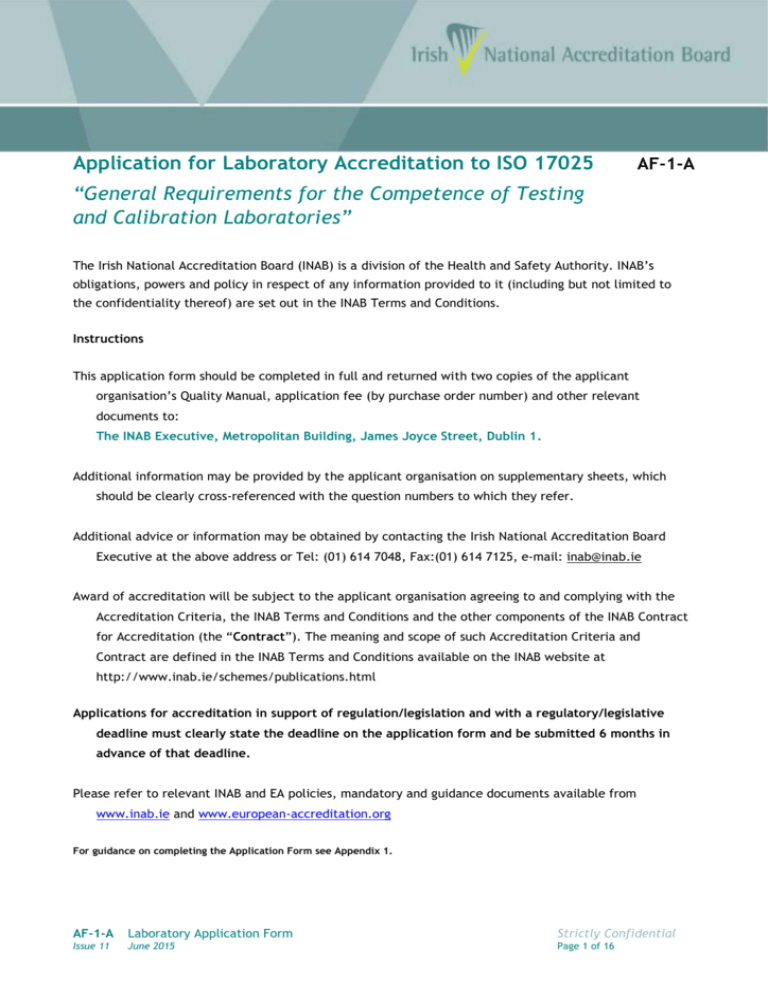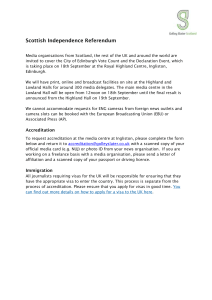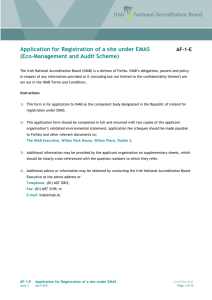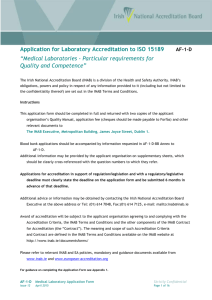Application for Laboratory Accreditation to ISO 17025
advertisement

Application for Laboratory Accreditation to ISO 17025 AF-1-A “General Requirements for the Competence of Testing and Calibration Laboratories” The Irish National Accreditation Board (INAB) is a division of the Health and Safety Authority. INAB’s obligations, powers and policy in respect of any information provided to it (including but not limited to the confidentiality thereof) are set out in the INAB Terms and Conditions. Instructions This application form should be completed in full and returned with two copies of the applicant organisation’s Quality Manual, application fee (by purchase order number) and other relevant documents to: The INAB Executive, Metropolitan Building, James Joyce Street, Dublin 1. Additional information may be provided by the applicant organisation on supplementary sheets, which should be clearly cross-referenced with the question numbers to which they refer. Additional advice or information may be obtained by contacting the Irish National Accreditation Board Executive at the above address or Tel: (01) 614 7048, Fax:(01) 614 7125, e-mail: inab@inab.ie Award of accreditation will be subject to the applicant organisation agreeing to and complying with the Accreditation Criteria, the INAB Terms and Conditions and the other components of the INAB Contract for Accreditation (the “Contract”). The meaning and scope of such Accreditation Criteria and Contract are defined in the INAB Terms and Conditions available on the INAB website at http://www.inab.ie/schemes/publications.html Applications for accreditation in support of regulation/legislation and with a regulatory/legislative deadline must clearly state the deadline on the application form and be submitted 6 months in advance of that deadline. Please refer to relevant INAB and EA policies, mandatory and guidance documents available from www.inab.ie and www.european-accreditation.org For guidance on completing the Application Form see Appendix 1. AF-1-A Laboratory Application Form Strictly Confidential Issue 11 June 2015 Page 1 of 16 General Information 1) AF-1-A Name, address, telephone, fax and e-mail of the applicant organisation. (Please ensure that the specific entity seeking accreditation and the legal entity are precisely identified. All invoicing will be directed to the main contact person). Note: These details will be used by INAB on INAB Directories, certificates, etc. (a) VAT Number: (b) Do you claim VAT exemption? Yes No If Yes, please attach a copy of the VAT Exemption Certificate (VAT Form 13B) (c) Purchase Order Number – Mandatory (to invoice the application fee). Please note application will not be accepted unless this PON is provided. 3) What is the legal status of the organisation? a) Owned by an individual: b) Owned by a private company or partnership: c) Owned by a public limited company: d) Owned by an organisation with activities/products/ Yes No Quality Manual Clause Reference services, other than those subject to the application for accreditation: e) Owned by an academic institution: f) Part of a learned or professional institution: g) Owned by a public body or nationalised industry: h) Another category? If so, please specify: i) Company Registration Number: AF-1-A Laboratory Application Form Strictly Confidential Issue 11 June 2015 Page 2 of 16 General Information 4) AF-1-A If the answer to 3 (d) is YES, what are the other activities/ products / services and describe their nature e.g. are they conducted for the parent company or outside organisations and are they certified or accredited? 5) If the Laboratory is part of a larger organisation, what is the relationship to that organisation? Note for Laboratories part of Government (public/civil servants), please define the relationship within Government. Please provide the name and other contact details of the parent organisation, if any. 6) Name and position (director level) of the organisation’s representative with authority to commit the applicant organisation to the requirements for accreditation. 7) Name and position of the applicant organisation’s main contact with the Irish National Accreditation Board. (This is the person to whom all correspondence from INAB will be addressed). AF-1-A Laboratory Application Form Strictly Confidential Issue 11 June 2015 Page 3 of 16 General Information 8) AF-1-A Name and position of the applicant organisation’s deputy contact with the Irish National Accreditation Board. Note: If contact details for questions 5 – 8 differ from Q1 please supply relevant details. 9) Locations covered by this application: See INAB Policy Statement, PS19 Yes N/A Complete and attach INAB Form PS19-F1 available on the INAB website 10) Countries from which the applicant organisation operates. Please identify those premises from which one or more key activities are performed (include all premises): See INAB Policy Statement, PS7. Yes N/A Complete and attach INAB Form PS7-F1 available on the INAB website 11) Numbers of staff employed by the applicant organisation in the fields where accreditation is sought. a) Technical: b) Other (incl. secretarial and support staff): AF-1-A Laboratory Application Form Strictly Confidential Issue 11 June 2015 Page 4 of 16 Section A AF-1-A List below the names, technical qualifications and experience of the following staff: A.1 Technical Manager (ref: ISO 17025 Sect. 4.1.5h): A.2 Deputy Technical Manager (ref: ISO 17025 Sect.4.1.5j): A.3 Quality Manager (ref: ISO 17025 Sect. 4.1.5i): A.4 Deputy Quality Manager (ref: ISO 17025 Sect.4.1.5j): A.5 All other staff authorised by the laboratory to sign Test Reports for scope of accreditation sought: AF-1-A Laboratory Application Form Strictly Confidential Issue 11 June 2015 Page 5 of 16 Section B B.1 AF-1-A In the table below specify as precisely as possible the scope of accreditation being sought. Continue on supplementary sheets as necessary. INAB Class No. (Ref: INAB P9) Materials or products tested/calibrated Type of test/calibration or property measured, and range of measurement* Relevant standard or documented procedure used Laboratory Category (A, B, C, D) Ref: INAB P7 * Calibration laboratories to quote calibration and measurement capability (CMC). Testing laboratories to have available an estimate of the uncertainty of measurement and detection limits for the tests for which accreditation is sought. AF-1-A Laboratory Application Form Strictly Confidential Issue 11 June 2015 Page 6 of 16 Section C C.1 AF-1-A List below the major items of laboratory equipment currently in use for the range of tests/calibrations listed in B.1 above. Equipment item (Name and make) Measurement/working range and other relevant information. AF-1-A Laboratory Application Form Strictly Confidential Issue 11 June 2015 Page 7 of 16 Section D AF-1-A Yes No Quality Manual Reference or other relevant reference D.1) Are procedures for the operation of the laboratory set out in the Quality Manual? D.2) Is an organisation chart contained in the quality manual? If not, please attach. D.3) Has the officer responsible for quality the responsibility and authority to identify quality problems and initiate effective solutions? D.4) Do procedures exist to control all documents that form part of the laboratory’s quality system? D.5) Do fully documented procedures exist to ensure review of requests, tenders and contracts? D.6) Are records maintained of all reviews of requests, tenders and contracts? D.7) Does the laboratory ever use sub-contractors for testing/calibration or associated technical services in connection with any of the work for which accreditation is being sought? D.8) Are all sub-contracted results clearly identified on test reports? D.9) Do procedures exist for the purchase, reception and storage of reagents, supplies and laboratory consumable materials that affect the quality of tests and/or calibrations? D.10) Are there procedures in place to ensure that the client is given full co-operation by the laboratory on all testing/calibration matters? D.11) Are arrangements in place to ensure the effective resolution of complaints received from clients or other parties? D.12) Do fully documented procedures exist to ensure adequate control of non-conforming testing and/or calibration work? D.13) Does the laboratory operate a programme of preventive action to identify needed improvements and potential sources of non-conformances? D.14) Is a record maintained of all equipment including calibration results? AF-1-A Laboratory Application Form Strictly Confidential Issue 11 June 2015 Page 8 of 16 Section D AF-1-A Yes No Quality Manual Reference or other relevant reference D.15) Are there arrangements for ensuring the accuracy, completeness and confidentiality of all relevant records? D.16) For what period does the laboratory retain the original recorded observations and derived data? D.17) Are there procedures in place to ensure the appropriate identification, collection, indexing, access, filing, storage, maintenance and disposal of quality and technical records? D.18) Where computers or automated equipment is used for the acquisition, processing, recording, reporting, storage or retrieval of test or calibration data has the software been validated? D.19) Is there a prescribed audit procedure for checking quality systems? D.20) How frequently are management reviews held? D.21) Are records of management reviews maintained? D.22) Have appropriate standards of qualifications and experience been prescribed for technical and managerial posts? D.23) Are the necessary training arrangements available to maintain the required quality of testing/calibration? D.24) Are adequate facilities and environments provided for calibration, handling, control, storage and maintenance of all testing and measuring equipment? D.25) Is provision made to ensure that environments in which tests/calibrations are undertaken are suitable for the measurements undertaken? D.26) Is there control of access to laboratories? D.27) Is provision made to prevent deterioration of damage to materials, samples and equipment both before and after tests/calibrations? D.28) Are storage methods prescribed, including special environments if necessary? AF-1-A Laboratory Application Form Strictly Confidential Issue 11 June 2015 Page 9 of 16 Section D AF-1-A Yes No Quality Manual Reference or other relevant reference D.29) Are there procedures for the inspection of samples in storage? D.30) Are there documented procedures for calibrating all equipment and reference standards covering the method of calibration, uncertainty of measurement, maximum interval between calibration and (where appropriate) the sealing of equipment after calibration? D.31) Are manuals, procedures and regulations for the tests/calibrations performed available to staff? D.32) Are formal specifications available for each test/calibration? D.33) Are non-standard testing techniques or calibrations used by the laboratory fully documented and appropriately validated? D.34) Are the standards methods used by the laboratory the latest valid editions? D.35) Does the laboratory have a policy and procedure to address uncertainty of measurement for test methods/calibrations? D.36) Are observations and calculations recorded in permanent workbooks or controlled forms? D.37) Are the reference standards used for calibration traceable to national or international standards? D.38) Do internal quality control procedures exist for monitoring the validity of tests and calibrations undertaken? AF-1-A Laboratory Application Form Strictly Confidential Issue 11 June 2015 Page 10 of 16 Section D D.39) AF-1-A What external proficiency testing (inter-laboratory comparisons) schemes does the laboratory participate in? Scheme Name Test/Calibration Methods Covered AF-1-A Laboratory Application Form Strictly Confidential Issue 11 June 2015 Page 11 of 16 Yes No Quality Manual Reference or other relevant reference D.40) Do test reports/calibration certificates contain all the information required in ISO 17025 section 5.10.2? D.41) What is the laboratory’s policy in relation to opinions and interpretations on test reports/calibration certificates? D.42) Do you consider that the laboratory complies at present with ISO 17025 “General requirements for the competence of testing and calibration laboratories” and INAB Publication R1 “Regulations for INAB accredited organisations”? D.43) Is there any special urgency for achieving INAB accreditation? If so, please give the reason. AF-1-A Laboratory Application Form Strictly Confidential Issue 11 June 2015 Page 12 of 16 Section E AF-1-A Statement by applicant organisation (the “Organisation”) (This should be signed for and on behalf of the Organisation by the technical manager of the Organisation and by the person designated in Q6 of General Information) The Organisation identified below hereby applies to INAB to assess the Organisation for its eligibility to be accredited as competent to provide the services specified in this application, having regard to relevant accreditation criteria and any other conditions or factors that INAB considers to be relevant to or to affect the Organisation’s competence for the specified services. The Organisation acknowledges that it has read the INAB Terms and Conditions and agrees to comply at all times, during the currency of the application made herein and any resulting accreditation, with the INAB Terms and Conditions as the same may be substituted, amended, supplemented or varied by INAB after the date of this application. In particular the Organisation notes the obligations as to insurance specified in clause 16 of the INAB Terms and Conditions and confirms that such insurances are either already in place or will be in place prior to the grant by INAB of any accreditation that may result from this application. Where an application for accreditation is being made by a government department or a body acting under the auspices of a government department where that body has no separate legal identity from that of the department, INAB does not require the relevant Minister to comply with the obligations as to insurance set out in clause 16 of the INAB Terms and Conditions. This is in recognition of the fact that government departments do not take out insurance to cover liabilities that may arise in their contractual arrangement. This exemption does not however affect the obligation of the relevant Minister to indemnify INAB in accordance with clauses 9 and 15 of the INAB Terms and Conditions. Further, the Organisation notes the fees set out in the fee schedule and payable in respect of the following: the assessment now applied for; assessment and inspection services; any resulting accreditation; renewal fees, surveillance fees and any other fees necessary to maintain, supervise or review any accreditation that may be obtained by the Organisation, including expenses of outside auditors etc., as any and all such fees may be substituted, amended, supplemented or varied by INAB after the date of this application and the Organisation agrees to pay such fees in accordance with the requirements set out in the INAB Terms and Conditions. The Organisation hereby confirms that it has a right to supply the data and information contained in this application or which it otherwise gives to INAB, and gives its own consent and confirms that it has obtained all properly informed consents from any individuals in respect of whom the Organisation is giving data or information to INAB to enable INAB to lawfully receive such data and information and make use thereof for the purposes of its functions (having particular regard to, but not limited to, applicable data protection legislation) and also confirms that all such data and information is complete, accurate and correct and that it will promptly provide any such further information and data as may be required by INAB to assess and process this application. AF-1-A Laboratory Application Form Strictly Confidential Issue 11 June 2015 Page 13 of 16 Section E (continued) AF-1-A Signed for and on behalf of: Name of Organisation by: Technical Manager Date Company Representative in Q6 of General Information Position Date In order that INAB might communicate with the Organisation with efficiency and speed, please indicate below the most up to date email address for the Organisation (and please update us of any change in such email address) so as to ensure that electronic notifications/communications from INAB might reach the principals of the Organisation and/or the appropriate contact within the Organisation for accreditation matters. Should the Organisation have any problem in or objection to receiving electronic communications from INAB, please let us know. E-mail address of accreditation contact within the Organisation: Email address AF-1-A Laboratory Application Form Strictly Confidential Issue 11 June 2015 Page 14 of 16 Section F For completion by INAB personnel only AF-1-A F.1 Laboratory Name: is assigned to INAB Officer: By: A. Duff, Manager, INAB F.2 Date Assessor(s) assigned by INAB Officer Name: Name: Name: Pre-assessment required: Yes No If yes, date of pre-assessment: If no, date of assessment: F.3 Application Review: Please highlight any issues observed in the application form review: INAB Officer Date AF-1-A Laboratory Application Form Strictly Confidential Issue 11 June 2015 Page 15 of 16 Appendix 1 AF-1-A General Information provides general information on the applicant organisation. Section A provides general information on the applicant organisation and its key personnel. Section B needs particularly careful consideration. The scope of accreditation of a laboratory is the formal statement of the range of activities for which the laboratory has been accredited: the scope of accreditation is recorded on the accreditation schedule, which is issued with a laboratory’s certificate of accreditation. It is INAB policy that a laboratory’s scope of accreditation be defined as precisely as possible so that clients will know accurately and unambiguously the range of tests/calibration that are covered by a laboratory’s accreditation. Save as may be relevant to the accreditation sought or as may be specified in Section B, the applicant organisation should exclude from Section B any activities for which accreditation is not being sought. (Please note that information on such activities may be required in the General Information Section however). The applicant organisation should specify as precisely as possible the tests or types of tests for which accreditation is sought. Wherever possible, the INAB classification number for each test should be entered in the first column. These are listed in INAB publication P9 “Classification system for testing and calibration”. The applicant organisation should indicate clearly the products or materials tested and should specify the particular property or properties measured, and the range of measurements concerned. If the applicant organisation is a calibration laboratory it should quote best measurement capability and if it is a testing laboratory it should have available an estimate of the uncertainty of measurement and detection limits for the tests for which accreditation is sought. The applicant organisation should list the national or international standards or documented procedure (with date of issue) relevant to the tests concerned and key techniques used to perform the tests. While the above guidelines should be followed wherever possible, INAB also recognises that it may be impractical for some applicant organisations to specify, in such precise detail its requested scope of accreditation and therefore some subsequent discussion, involving the applicant organisation, the lead assessor and the INAB Executive, will generally be required before the scope of accreditation applied for can be finalised in a form acceptable to all concerned. Section C requires information on major equipment items only. It is not necessary to list, for instance volumetric glassware if the applicant organisation is a chemical laboratory. Section D consists mainly of a series of yes/no questions relating to the operation of the applicant organisation. It is expected that the applicant organisation should be able to give affirmative answers to most of the questions and quote a relevant clause in its quality manual which confirms the point. Explanation will be required for negative answers. AF-1-A Laboratory Application Form Strictly Confidential Issue 11 June 2015 Page 16 of 16







